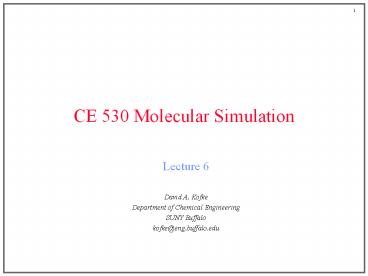CE%20530%20Molecular%20Simulation - PowerPoint PPT Presentation
Title:
CE%20530%20Molecular%20Simulation
Description:
Department of Chemical Engineering. SUNY Buffalo. kofke_at_eng.buffalo.edu. 2. Statistical Mechanics ... time average is equivalent to ensemble average ... – PowerPoint PPT presentation
Number of Views:28
Avg rating:3.0/5.0
Title: CE%20530%20Molecular%20Simulation
1
CE 530 Molecular Simulation
- Lecture 6
- David A. Kofke
- Department of Chemical Engineering
- SUNY Buffalo
- kofke_at_eng.buffalo.edu
2
Statistical Mechanics
- Theoretical basis for derivation of macroscopic
behaviors from microscopic origins - Two fundamental postulates of equilibrium
statistical mechanics - microstates of equal energy are equally likely
- time average is equivalent to ensemble average
- Formalism extends postulates to more useful
situations - thermal, mechanical, and/or chemical equilibrium
with reservoirs - systems at constant T, P, and/or m
- yields new formulas for probabilities of
microstates - derivation invokes thermodynamic limit of very
large system - Macroscopic observables given as a weighted sum
over microstates - dynamic properties require additional formalism
3
Ensembles
- Definition of an ensemble
- Collection of microstates subject to at least one
extensive constraint - microstate is specification of all atom
positions and momenta - fixed total energy, total volume, and/or total
number of molecules - unconstrained extensive quantities are
represented by full range of possible values - Probability distribution p describing the
likelihood of observing each state, or the weight
that each state has in ensemble average - Example Some members of ensemble of fixed N
- isothermal-isobaric (TPN)
- all energies and volumes represented
Low-probability state
4
Commonly Encountered Ensembles
5
Partition Functions
- The normalization constants of the probability
distributions are physically significant - known as the partition function
- relates to a corresponding free energy, or
thermodynamic potential, via a bridge equation
6
Ensemble and Time Averaging
- Configuration given by all positions and momenta
- phase space G (pN,rN)
- Configuration variable A(rN,pN)
- Ensemble average
- Weighted sum over all members of ensemble
- In general
- For example, canonical ensemble, classical
mechanics - Time average
- Sum over all states encountered in dynamical
trajectory of system
rN shorthand for positions of all N atoms
Should average over initial conditions
Given by equations of motion
7
Ergodicity
- If a time average does not give complete
representation of full ensemble, system is
non-ergodic - Truly nonergodic no way there from here
- Practically nonergodic very hard to find route
from here to there - Term applies to any algorithm that purports to
generate a representative set of configurations
from the ensemble - Click here for an applet describing ergodicity.
Phase space
8
Separation of the Energy
- Total energy is sum of kinetic and potential
parts - E(pN,rN) K(pN) U(rN)
- Kinetic energy is quadratic in momenta
- Kinetic contribution can be treated analytically
in partition function - And it drops out of position averages
thermal de Broglie wavelength
configuration integral
9
Simple Averages 1. Energy
- Average energy
- Note thermodynamic connection
- Average kinetic energy
- Average potential energy
definition of Q calculus
bridge equation
Gibbs-Helmholtz equation
Equipartition of energy kT/2 for each degree of
freedom
10
Simple Averages 2. Temperature
- Need to measure temperature in microcanonical
ensemble (NVE) simulations - Define instantaneous kinetic temperature
- Thermodynamic temperature is then given as
ensemble average - Relies on equipartition as developed in canonical
ensemble - A better formulation has been developed recently
More generally, divide by number of molecular
degrees of freedom instead of 3N
11
Simple Averages 3a. Pressure
- From thermodynamics and bridge equation
- Volume appears in limits of integration
- Scale coordinates to move volume dependence into
the potential - L-derivative of U is related to force
- Result
V L3
L
1
12
Simple Averages 3b. Hard-Sphere Pressure
- Force is zero except at collision
- Time integration of virial over instant of
collision is finite - contribution over instant of collision
- Pressure is sum over collisions
equal masses
13
Simple Averages 4. Heat Capacity
- Example of a 2nd derivative property
- Expressible in terms of fluctuations of the
energy - Other 2nd-derivative or fluctuation properties
- isothermal compressibility
Note difference between two O(N2) quantities to
give a quantity of O(N)
14
(Not) Simple Averages 5. Free Energy
- Free energy given as partition-function integral
- Impossible to evaluate
- Even numerically!
- Click here for an applet demonstrating the
difficulty - Return to this topic later in course
15
Fluctuations
- How complete is the mean as a statistic of
ensemble behavior? - Are there many members of the ensemble that have
properties that deviate substantially from the
mean? - Look at the standard deviation s
- This relates to the heat capacity
- Relative to mean is the important measure
- Fluctuations vanish in thermodynamic limit N??
- Similar measures apply in other ensembles
- volume fluctuations in NPT molecule-number
fluctuations in mVT - Click here for an applet illustrating fluctuations
p(E)
sE
E
ltEgt































